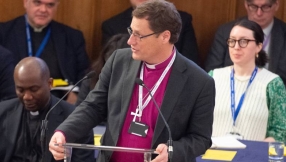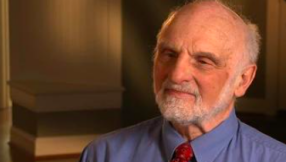
The writer of the Letter to the Hebrews reminds Christians that they are surrounded by a great "cloud of witnesses." (NRSV) That "cloud" has continued to grow in size since then. In this monthly column we will be thinking about some of the people and events, over the past 2,000 years, that have helped make up this "cloud." People and events that have helped build the community of the Christian church as it exists today.
Today, most people's mental image of Vikings is of pagan marauders who destroyed Christian churches and ransacked monasteries. They are rarely imagined in church, unless it was to strike down a monk or seize a jewelled reliquary as loot.
There is a lot of truth to this image and yet, as with so much in history, the reality was more complex. Outside of Scandinavia, Vikings converted to Christianity within a couple of generations after their first settlement. This was true from Ireland to Ukraine. Back home, in the Scandinavian homelands, the conversion took a little longer but by the year 1000 – when Iceland converted to the Christian faith – most of the Viking world was well on the way towards that or had been in that position for several decades.
However, there was resistance to the new faith in some places and the pace of change varied. In Sweden, for example, it was well into the eleventh century before substantial progress was made. In Norway, the matter was made more complex because the (now Christian) kings of Denmark fished in the troubled waters of Norwegian politics and played different groups (pagans and Christians) against each other in a violent game of royal power politics.
It was as part of this power struggle, in 1030, that a Christian king of Norway took on the powerful pagan nobles who opposed him – and lost. Yet, in so doing he embarked on a posthumous journey that would see him become a patron saint and be revered as the Viking who had died for the cause of Christ.
The Christian conversion of Norway
The Norwegian king, known as Hakon the Good, tried to convert Norway in the tenth century but gave up in the face of pagan resistance. After this, missionaries from England and Germany had some limited success and the coastal distribution of large stone crosses in Norway indicates the start of Christian communities there.
This process was assisted by the reign of Olaf Tryggvason (995-1000). However, it was under King Olaf Haraldsson or Olaf II (later known as St Olaf) that the conversion took off in the 1020s, assisted by missionaries from Normandy (the duchy of the 'North Men'), whose Norse roots assisted them in making an impact on other Scandinavian peoples. This conversion, as we shall see, also included a lot of violence.
The two main Norwegian missionary kings, Olaf Tryggvason and Olaf Haraldsson, were both converted to the Christian faith abroad. Olaf Tryggvason was baptised in England, as part of a peace agreement with the Anglo-Saxon ruler. Olaf Haraldsson was baptised in Normandy, possibly in connection with the exiled Anglo-Saxon king, Æthelred II (the Unready) who was there because England and Denmark at the time were part of a northern empire having been conquered by the ruler of Denmark (a situation which lasted until 1042).
The Norman historian, William of Jumieges, tells us that Olaf Haraldsson was baptised in Rouen in 1013 or 1014 and this is likely to be correct. This is also referred to by the twelfth-century Norwegian monk-chronicler Theodoricus Monachus who also refers to an alternative Norwegian-Icelandic tradition whereby Olaf Haraldsson was baptised as a child by Olaf Tryggvason. This, though, is almost certainly fictitious.
When Olaf Haraldsson eventually became king of Norway, in 1015, he brought with him many priests and bishops from England but, according to the German chronicler Adam of Bremen, he also established contact with Hamburg-Bremen in Germany and asked for missionaries to be sent from there too.
The conversion of both Olaf Tryggvason and Olaf Haraldsson, and the involvement of an English king and his funding of both their campaigns for kingship in Norway, shows that being allied to a Christian ruler was very beneficial for Norwegian claimants to the throne back home. In Norway, Olaf Tryggvason then set about converting the kingdom by the sword and used Christianity as a tool with which to control his realm and bring dissidents into line. He met his death in battle, in the year 1000, facing an alliance of the king of Denmark, the ruler of Sweden (both of which were Christian) and – a forerunner of future bloody events – Norwegians whose commitment to Christianity was minimal or non-existent.
Olaf Haraldsson carried out his own campaign of conversion through evangelization both by force and through legislation. Although Christianity must have spread due to the initiative of many men and women – and not just due to the conversion of kings – Norwegian kings played a significant role in pushing it forward.
Denmark and Norway
For years in the Viking Age the kings of Denmark attempted to also control their northern neighbours in Norway and in Sweden. As we have seen, Olaf Tryggvason, funded by the English crown, returned from raiding England to Norway and became king there. However, when Svein Forkbeard of Denmark (with the support of the Swedish king) defeated and killed him, Svein restored the Norwegian jarls (earls) of Lade to their position as his sub-rulers of the country. The jarls of Lade (with a powerbase at modern Trondheim in northern Norway) effectively acted as the agents of the Danish king. The jarls of Lade were pagan, or only nominally Christian, and resisted Christianization.
However, the political and military situation was fluid and the defeat of the jarl of Lade (the ally of the Danes) by Olaf Haraldsson at the battle of Nesjar, in 1015, meant that King Cnut of Denmark lost control over Norway. Olaf Haraldsson ruled Norway from 1015 to 1028.
The next challenge to the dominant Danes occurred at the Battle of Holy River, in 1026. This battle followed a joint venture by the new king of Norway and the new king of Sweden to challenge King Cnut. The Anglo-Saxon Chronicle reports that Cnut's enemies won; however contemporary Scandinavian poetry suggests that Cnut was victorious! One thing is certain and that is that the battle was hard fought and the outcome contested.
It is likely that the battle was something of a stalemate, in which neither side could land the killer blow. Despite this, Cnut, in a letter to his English subjects, claimed he was now king of England, Denmark, Norway and some of the Swedes. He was probably claiming too much since, in 1027, he was buying the support of Norwegian nobles against Olaf Haraldsson, who was still on the throne.
Many of these Norwegian nobles were pagan and opposed the Christian conversion that was being enthusiastically sponsored by King Olaf Haraldsson. It was a commitment which would cost the king his life.
In 1028, Cnut struck at Norway. Olaf Haraldsson's rule had already been weakened by pagan reactions to his determined Christianity. Cnut – also a Christian but more focused on domination of Norway than on matters of religion there – undermined him further by bribing key Norwegians and promising them greater freedom. Realpolitik had trumped faith.
This eventually led to Olaf Haraldsson's death, in 1030, at the Battle of Stiklestad, at the hands of (mostly pagan) Norwegians allied to Cnut of Denmark. Those who sided with Olaf also sided with his Christian faith.
The later Icelandic historian, Snorri Sturluson (looking back from the vantage point of the thirteenth century), recorded that Olaf's men charged into battle shouting, "Fram kristmenn, krossmenn, kongsmenn alle!" ("Onward, Christ's men, cross men, king's men all!"). This stirring battle-cry was derived from the Christian hymn, known as the Sanctus. They were defeated and Olaf Haraldsson was killed.
Cnut's ambitions had borne fruit and he appointed Jarl Hakon of Lade as his governor and then, when Hakon died, Cnut named his own son as king of Norway. However, the Norwegians soon grew restless under the taxation and harsh rule of this particular foreign king. This was combined with the growing cult of the dead king (now St) Olaf Haraldsson; despite the fact that he had died at the hands of dissatisfied Norwegians! Clearly, some people were having second thoughts over backing the king of Denmark against their own Christian monarch.
The translation of the body of St. Olaf Haraldsson to Nidaros cathedral (Trondheim), in 1031, highlighted the way the dead king was now revered as a saint and as a martyr for both Christianity and Norwegian independence. By 1034, Norway had asserted its independence from Denmark in decisive fashion and driven out Cnut's son. Cnut the Great had been outmanoeuvred.
The Viking who died for Christ
Olaf Haraldsson had died because pagan Norwegian nobles allied themselves with a Danish Christian king due to their resentment at Olaf's dominance and his Christianization policies. However, only a year after his death he was canonized and became a symbol of Norwegian national independence in the face of an increasingly resented Danish overlordship.
Today, Olaf is the patron saint of Norway and is remembered as a key figure in the Christian conversion of Norway. His popularity led to churches being dedicated to him in England as well as in Norway.
Today, busy London commuters walking past St Olave's Church, Hart Street, in the City of London, near Fenchurch Street railway station, may know this small church as one of only a handful of medieval City churches that escaped the Great Fire of London in 1666. They might be more surprised to discover that this ancient building is named after the patron saint of Norway.
This Norwegian connection explains why, during the Second World War, the exiled King Haakon VII of Norway worshipped there. The name of this little church is a reminder of a turbulent period of Scandinavian history and of a Viking warrior-king who (even when some complex politics are considered) died for Christ and saw his army as kristmenn, krossmenn (Christ's men, men of the cross), as they charged to their deaths.
Martyn Whittock is an evangelical historian and a Licensed Lay Minister in the Church of England. As an historian and author, or co-author, of fifty-four books, his work covers a wide range of historical and theological themes. In addition, as a commentator and columnist, he has written for several print and online news platforms; has been interviewed on radio and TV exploring the interaction of faith and politics, and historical perspectives on current events; and appeared on the news discussing political events in the USA, the war in Ukraine, and the death of Queen Elizabeth II.
His most recent books include: Trump and the Puritans (2020), The Secret History of Soviet Russia's Police State (2020), Daughters of Eve (2021), Jesus the Unauthorized Biography (2021), The End Times, Again? (2021) and The Story of the Cross (2021). He also has an interest in medieval history, being the author of A Brief History of Life in the Middle Ages (2009), The Vikings: From Odin to Christ (2018), and several other books on the Viking Wars.













